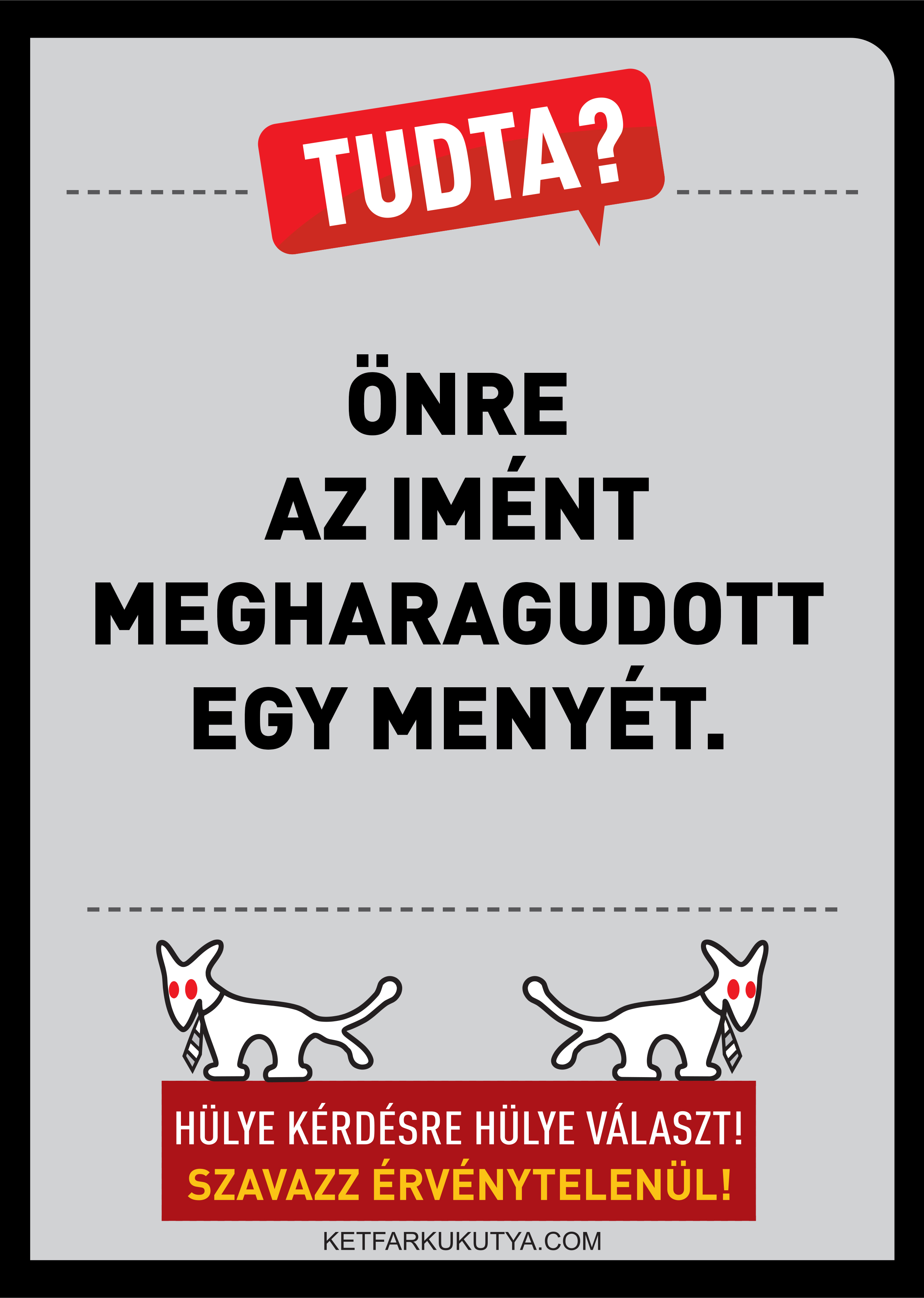Most of our everyday activity is social. We as individuals aim to belong to certain communities, so we prove this belonging via our actions, by how we dress, behave etc. We certainly enjoy being parts of social classes, thus we work constantly on these belongings – at least to enjoy the priviledges coming with them. That is what we call being civilized, or to put it more simply: it is what we call culture.
We want to belong to a community, enjoy the priviledges of being part of a social class. Being part of a community has obvious advantages. If you hunt mammoths, you have much more chance being successful as a member of a group of hunters than alone.
Social belonging brings certain priviledges for the individual; for centuries being an intellectual, a scientist or artist required belonging to a sponsoring authority, and all cultural products served the representation of economical and political power.
That is the reason why we see sometimes rather questionable personalities portrayed on masterpieces of visual arts.



Equestrian statue of Marcus Aurelius erected around 175 AD


photo by Didier Descouens – Own work, CC BY-SA 4.0, https://commons.wikimedia.org/w/index.php?curid=64674384
Until the late 18th century visual arts served almost exclusively as the representation of power. The quite rare examples to expose injustice, critique power structures, and inspire social change are quite metaphorical.

Pieter Bruegel the Elder, “The Massacre of the Innocents” (c. 1565-1567, 109.2×158.1 cm, British Royal Collection) depicts the biblical story of King Herod ordering the slaughter of all male infants in Bethlehem. While rooted in religious narrative, the painting also reflects the political turmoil and violence of Bruegel’s time, with the Spanish Inquisition and religious wars raging across Europe.
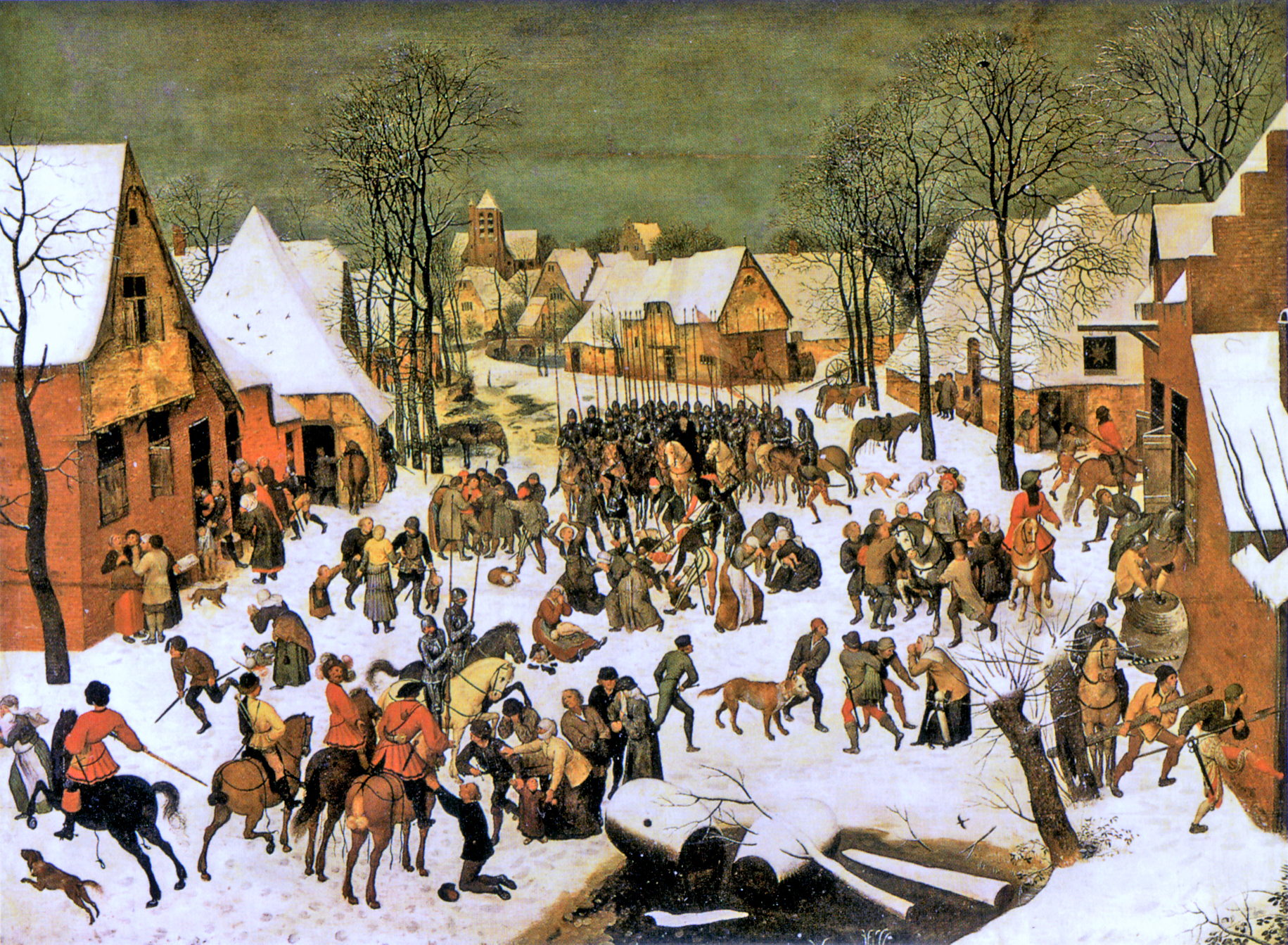
The Renaissance marked a shift towards individualism and humanism, emphasizing the importance of personal expression and creativity. Artists like Michelangelo and Leonardo da Vinci began to assert their independence from traditional patrons and to explore new artistic styles and techniques.

Piero della Francesca’s artistic career was deeply intertwined with the patronage system prevalent in Renaissance Italy. His success and ability to create groundbreaking works were largely due to the support and commissions he received from influential patrons. These patrons not only provided financial backing but also shaped the themes and subjects of his art, reflecting their own interests, values, and political agendas.
Piero’s early career was primarily based in his hometown of Sansepolcro and the surrounding region. He received commissions from local religious confraternities and wealthy families, such as the Bacci family, who commissioned the “Baptism of Christ.” These early works established his reputation as a skilled painter with a strong understanding of perspective and a unique artistic vision.
As Piero’s fame grew, he attracted the attention of more powerful patrons, including Sigismondo Pandolfo Malatesta, Lord of Rimini, and Pope Pius II. These influential figures commissioned Piero to create ambitious projects, such as the frescoes in the Tempio Malatestiano in Rimini and the now-lost frescoes in the Vatican Palace. These commissions not only provided Piero with greater financial security but also exposed his work to a wider audience, further enhancing his reputation.

Piero’s most significant patron was Federico da Montefeltro, Duke of Urbino, and his wife Battista Sforza. The Duke, a renowned humanist and military leader, was a discerning patron of the arts, and he commissioned Piero to create several important works, including the famous double portrait of the Duke and Duchess, as well as the altarpiece of the “Madonna of Senigallia.” The Duke’s patronage provided Piero with the resources and intellectual stimulation to experiment with new techniques and ideas, contributing to his artistic development.

Leonardo began his artistic career in Florence, where he apprenticed under the renowned painter and sculptor Andrea del Verrocchio. During this time, he likely received some support from the Medici family, the de facto rulers of Florence and prominent patrons of the arts. However, Leonardo’s ambitious and independent spirit eventually led him to seek out other patrons who could offer him more challenging and lucrative projects.
In 1482, Leonardo entered the service of Ludovico Sforza, the Duke of Milan. Sforza was a powerful and ambitious ruler who sought to enhance his prestige through art and culture. Leonardo’s multifaceted talents as an artist, engineer, and inventor made him an invaluable asset to the Milanese court.



During his time in Milan, Leonardo produced some of his most famous works, including the “Last Supper” mural for the monastery of Santa Maria delle Grazie and the equestrian monument to Francesco Sforza, Ludovico’s father (although the latter was never completed due to political upheaval). Leonardo also worked on various engineering projects for the Duke, designing military fortifications, canals, and even a mechanical lion that could walk and roar.

Courtesy of the National Museum, Krakow.

In 1502, Leonardo briefly entered the service of Cesare Borgia, the ruthless son of Pope Alexander VI. Borgia was a skilled military leader and strategist who sought to consolidate his power in central Italy. Leonardo’s expertise in military engineering made him a valuable asset to Borgia’s campaigns, and he designed innovative weapons and fortifications for the warlord.
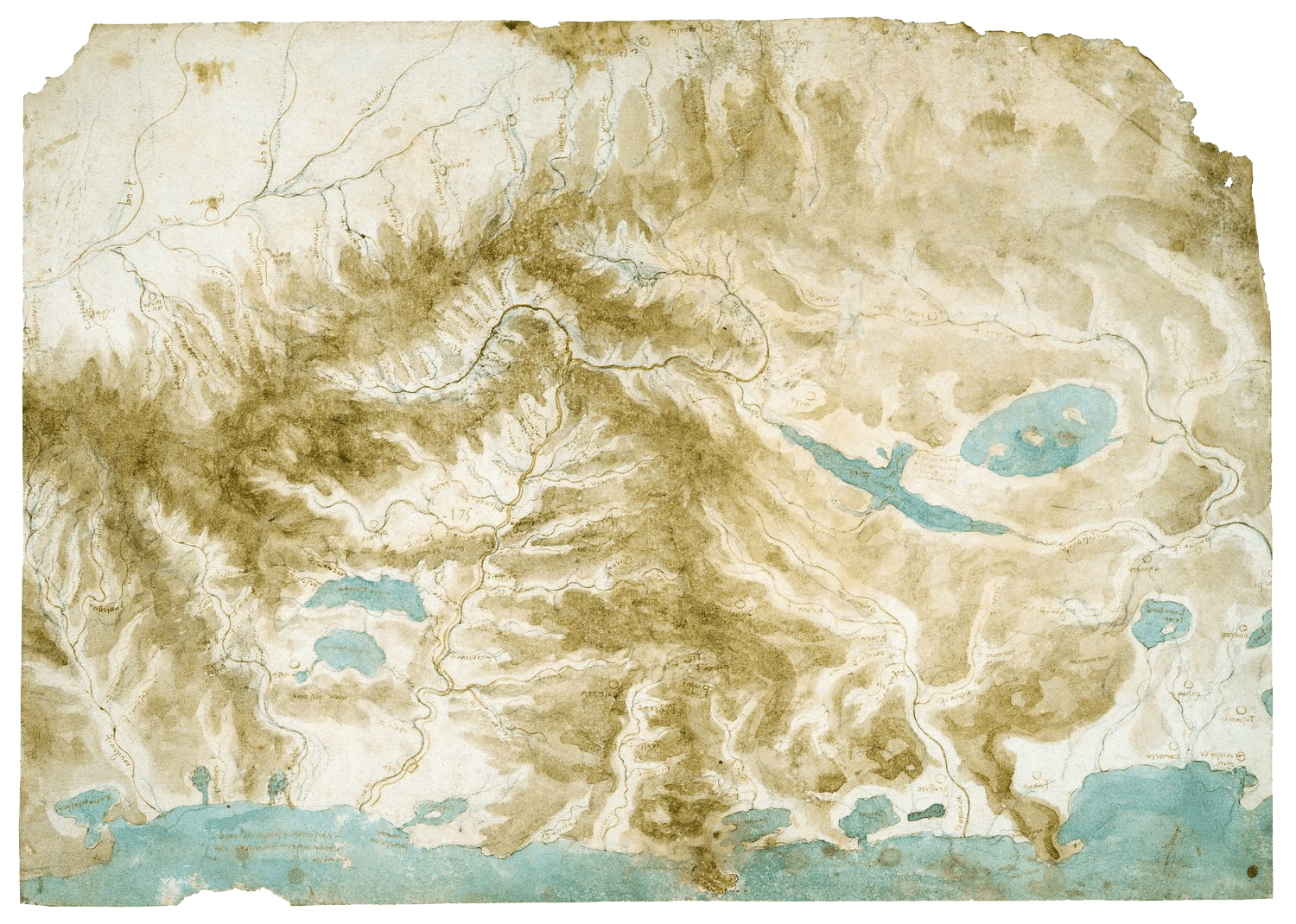
Map of the Arno Valley (1503-1504)
While working for Borgia, Leonardo created this detailed map of the Arno Valley in central Italy, which was strategically important for military purposes. The map demonstrates Leonardo’s cartographic skills and his ability to combine artistic and scientific approaches to mapmaking.
In 1516, Leonardo moved to France at the invitation of King Francis I, who offered him a generous stipend and a residence at the Chateau of Clos Lucé. Although Leonardo was in his sixties by this time and his health was declining, he continued to work on various projects for the king, including designing elaborate court festivals and planning a new royal palace.

The Enlightenment, also known as the Age of Reason, was a cultural and intellectual movement of the 17th and 18th centuries that emphasized reason, individualism, and skepticism over tradition and religious dogma. This philosophical shift had a profound impact on the visual arts, leading to the emergence of new styles, themes, and approaches to representation.

The Death of Socrates (1787) by Jacques-Louis David depicts the philosopher Socrates choosing death rather than renouncing his beliefs. It symbolizes the importance of intellectual integrity and the pursuit of truth, even in the face of adversity.
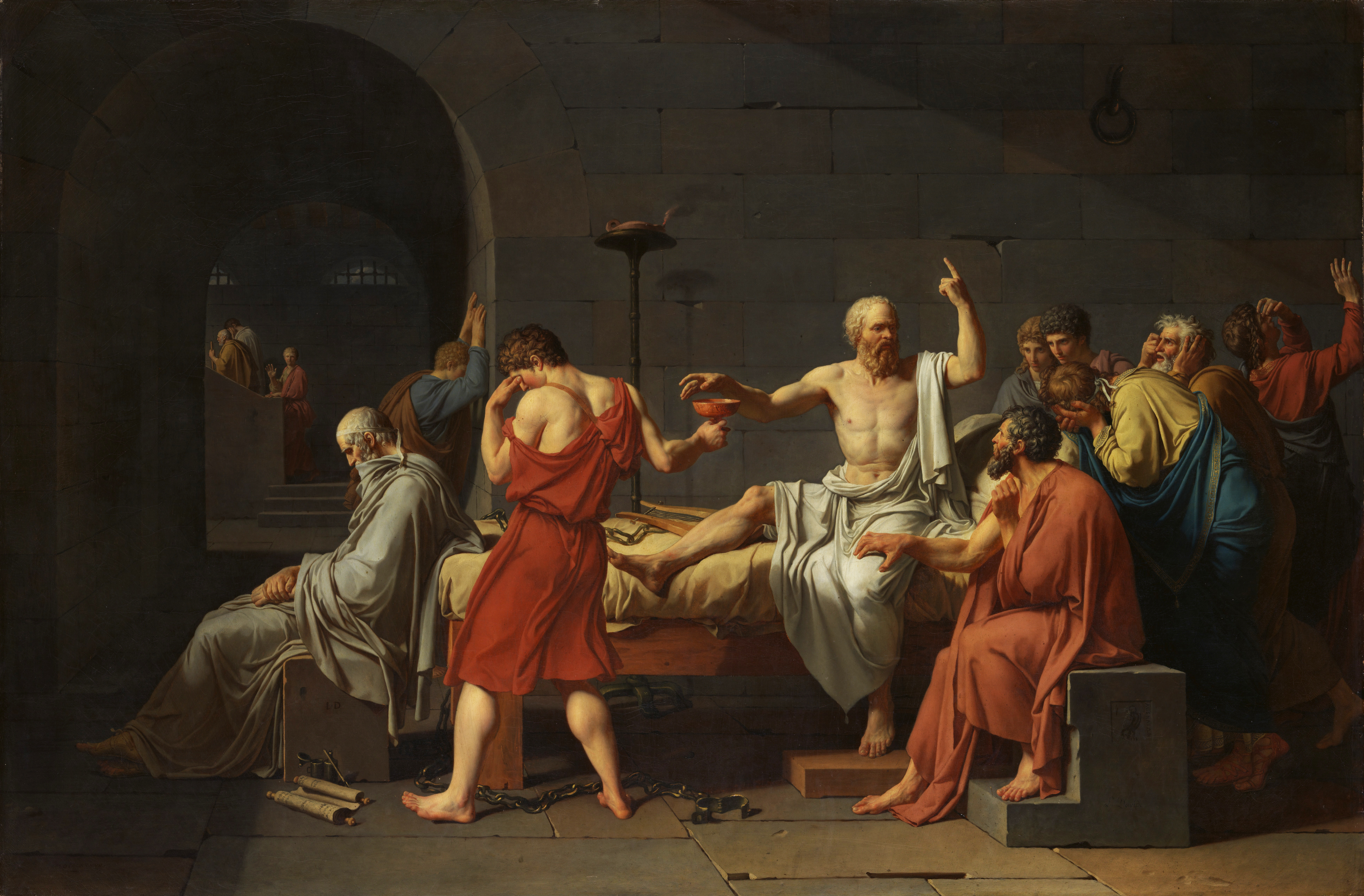
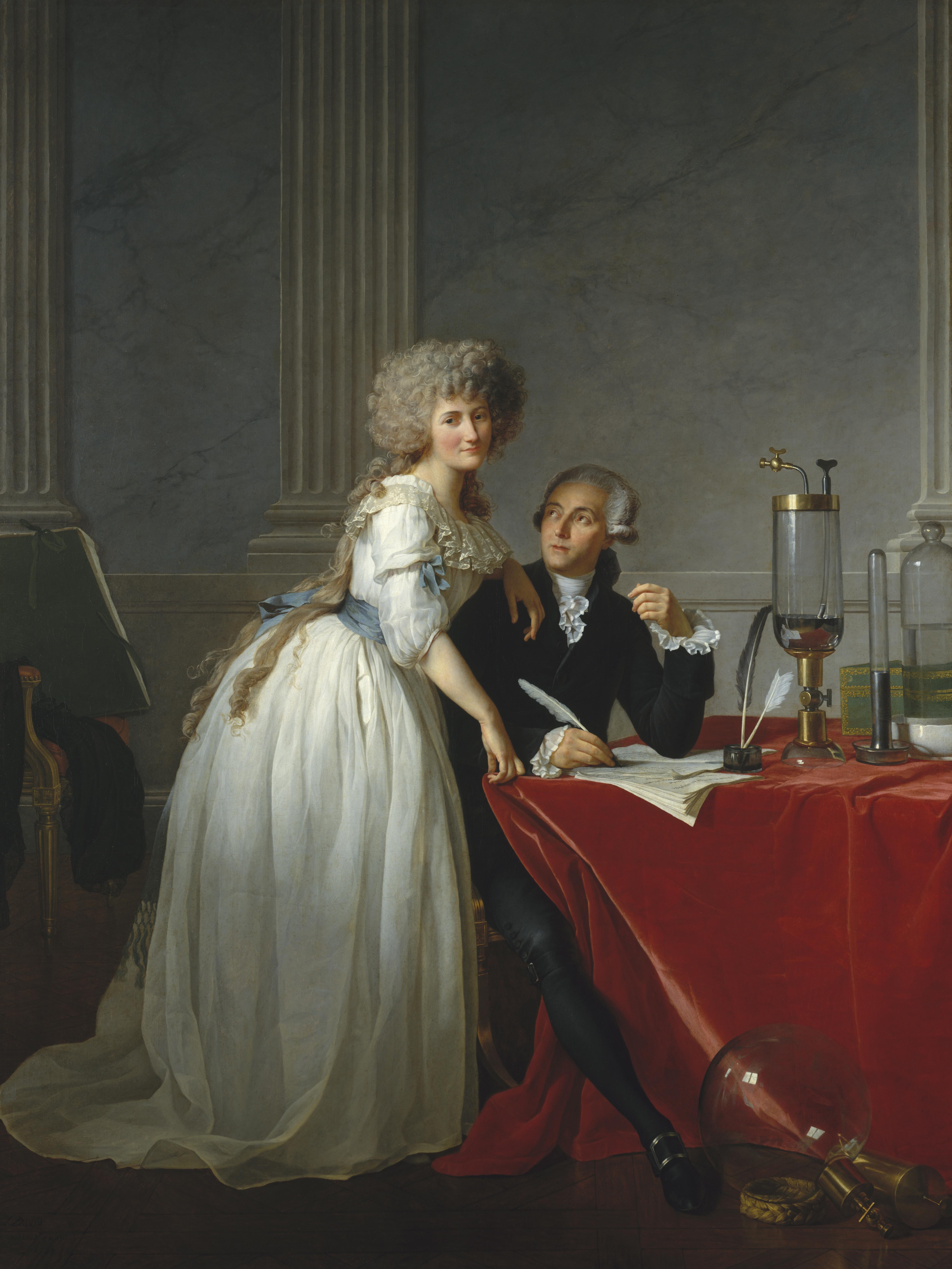
Jacques Louis David (French, 1748–1825). Antoine-Laurent Lavoisier and Marie Anne Pierette Paulze, 1788.
Oil on canvas; 259.7 x 194.6 cm, New York: Metropolitan Museum of Art
The period’s emphasis on reason, science, and individual liberty inspired artists to create works that celebrated intellectual curiosity, social progress, and the human potential for self-governance.


This painting captures the dramatic moment when members of the French National Assembly swore an oath to create a new constitution for France, symbolizing the revolutionary spirit and the desire for political reform that characterized the Enlightenment.

The idea of the independent artist comes from Romanticism, along with the virtue to activism against political power.
Nikolaus Harnoncourt’s masterclass Salzburg Festival with Simon Bolivar Orchestra (Venezuela’s youth orchestras are run under the auspices of the Fundación Musical Simón Bolívar (FMSB), formerly known as the Fundacion del Estado para el Sistema Nacional de las Orquestas Juveniles e Infantiles de Venezuela, known colloquially as El Sistema. El Sistema began under the leadership of José Antonio Abreu (7 May 1939 – 24 March 2018) with 11 students in an underground parking garage. The program has a reputation for rescuing young people in impoverished circumstances, directing them away from lives of drug abuse and crime, into which they would likely otherwise be drawn. Abreu has said that “music has to be recognized as an agent of social development in the highest sense because it transmits the highest values – solidarity, harmony, mutual compassion,” crediting it with the ability to “unite an entire community and express sublime feelings.”)

1800, oil on canvas, 273x234cm




Théodore Géricault’s “The Raft of the Medusa” (1818-1819) is a monumental painting that has become an icon of French Romanticism. It depicts the aftermath of the wreck of the French naval frigate Méduse, which ran aground off the coast of West Africa in 1816. The painting is a powerful indictment of the incompetence and corruption of the French government, which led to the disaster and the subsequent abandonment of over 140 survivors on a makeshift raft.
The painting depicts a moment of heightened drama and desperation, as the survivors on the raft spot a ship on the horizon and desperately try to signal it. The figures are depicted with raw emotion and physical intensity, their bodies contorted in pain and exhaustion. The composition is dynamic and chaotic, with the diagonal lines of the raft and the figures’ limbs creating a sense of urgency and instability.




The painting’s significance lies not only in its artistic merit but also in its political and social commentary. It exposed the corruption and incompetence of the French government, which had attempted to cover up the Méduse disaster. The painting also resonated with the public’s growing disillusionment with the post-Napoleonic regime and its failure to address the social and economic problems of the day.


directed by Nikolai Evreinov, set designs by Yuri Annenkov
“…And all around me, I saw life changing: the theater moved out onto the street, and the street moved into the theater. The “Theater of October” burst forth.
The tempo of change in the theaters varied—some of them remained skeptical for a long time and balked at the idea of changing. In Petrograd, Meyerhold, that indefatigable experimenter, was one of the first of the theater people to support the Communists outright. He sought contact with factory workers, the Red Guard, and the Komsomol, and he organized theater circles everywhere he could. He even wore the uniform of the Red Guard. His production The Storming of the Winter Palace became a model for mass productions in the open, where thousands participated and tens of thousands watched. His productions of revolutionary plays—Mystery-Bouffe, The Earth in Turmoil, Trust D. E., and so on—continued his earlier experiments (the elimination of the apron of the stage, the exposure of theater machinery, addressing the audience, a “limited” style of decoration) and brought about important innovations: tendentious, direct journalism; sociological characterization; open revue-like dramaturgy; the constructivist stage, etc. … My own work as a director and critic owed a great deal to Meyerhold. …” A Memoir by Asja Lācis

“In times of struggle, art has to be both an ally and friend of those in conflict. In this century of struggle, we look for art in the magnificent, free life. In it the creative process reveals itself through an intense and free action of the spirit, through masses that flow united by a common exhilarating rhythm. This kind of art-making also finds frequent and manifold expressions in the theater of the century of struggle. Theater in its essence is a collective experience; it is a synthesis of arts, directed toward the future. Theater has an enormous impact on the masses, but in comparison to other art forms, such as painting, it has progressed to a much lesser extent, explored less, developed fewer traditions, especially here in Latvia.
When theater started to become stationary under the weight of capitalism, reformers of theater emerged, looking to banish this immobility. Many instrumental reforms derived from circles of amateurs, artists, and literates, rather than professionals. Such reformers were Stanislavski, Fuchs, Reinhardt, Craig, Evreinov, Komissarzhevsky, Tairov, Meyerhold. Stanislasvki had already expressed everything with his naturalism, and his pupils in Russia (3rd Studio) are elaborating new forms of theater. These above-mentioned revolutionary theater directors have already created their traditions, their schools. Tairov, in his chamber theater piece Princess Brambilla, has created a synthetic play, where all performing arts are merged together: comedy, tragedy, ballet, circus, operetta, all coadunated by a common rhythm. Today’s theater is a kind of cabinet of experimentation that generates new traditions.
This cabinet keeps collectivism useful, since its most recent plays are improvisations put on by the whole collective. Another trend, not a laboratorial one, but a life-bringing movement, advances directly toward the street and assumes the form of mass demonstrations, community festivals, and mass improvisations. The bottom line here is collectivity and amateur theater. Theater here wants to merge with life. Prophets of this new type of theater are Kerzhentsev and Meyerhold. Theater embraces the reality of life more fully than any other field of art. Music is art in time, painting is art in space. Poetry attempts to unite time and space. Theater genuinely unites time and space—creating harmony rather than fracture. Theater embraces music, dance, and a specific art of acting. All this is bound together by an artist—the director. ” (Asja Lacis: New Tendencies in Theater, source: https://www.documenta14.de/en/south/ Signals from Another World: Proletarian Theater as a Site for Education Texts by Asja Lācis and Walter Benjamin, with an introduction by Andris Brinkmanis)


offset print, 98.5 × 69.5 cm.
Literature and Music Museum, Riga

“Program for a Proletarian Children’s Theater”
(Zentralrat der sozialistischen Kinderläden West-Berlin, 1969), 21 × 15.5 cm.
Walter Benjamin Archives, Berlin


.jpg)







The public could view television at seven public viewing rooms in Berlin and one in Potsdam. These were typically equipped with a number of domestic sized receivers with screen size 19 x 22 cm using a 180 line non-interlaced 25 Hz frame rate. The viewing rooms could seat between 30 and 40 people and the plan was for 25 such rooms and two theatres, one seating 100 and the other 300 people, to be available during the games and extending as far as Leipzig.
source: http://www.nostalgiatech.co.uk/Berlin%20Olympics.htm














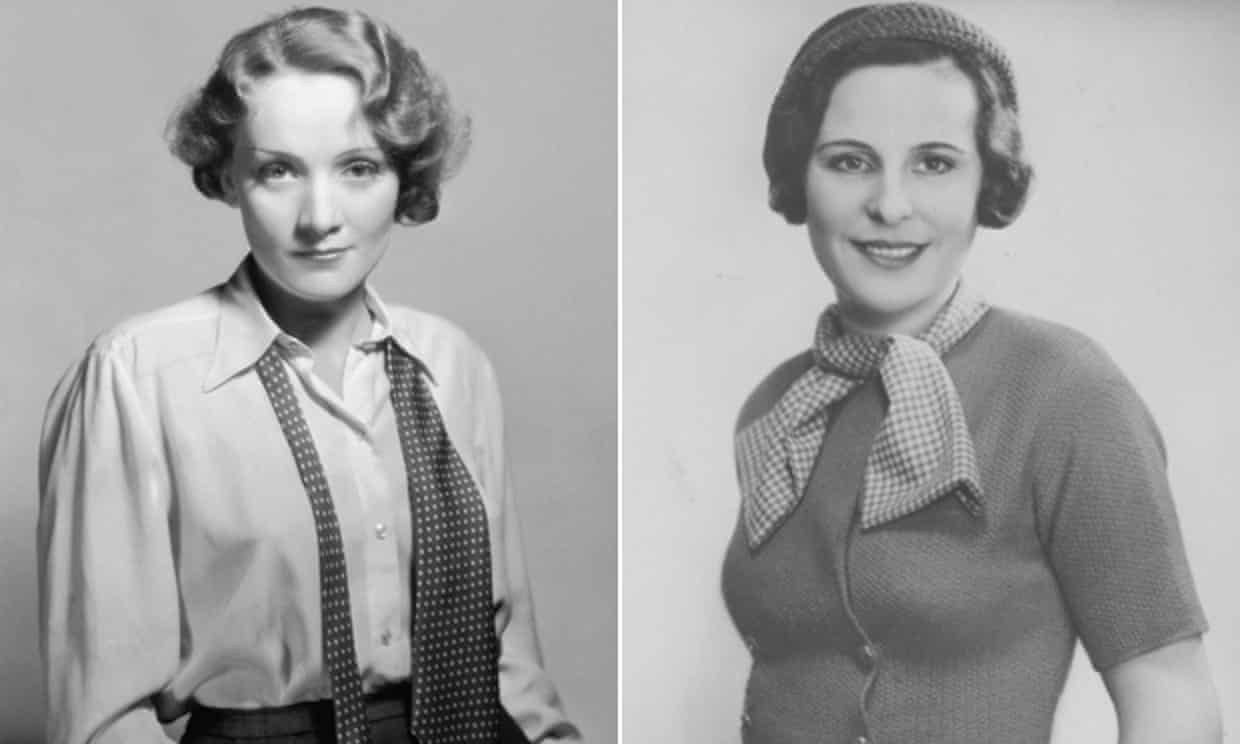




(most of the footages filmed in 1942)






Although the Nuba are black, not Aryan, Riefenstahl’s portrait of them is consistent with some of the larger themes of Nazi ideology: the contrast between the clean and the impure, the incorruptible and the defiled, the physical and the mental, the joyful and the critical. […] What is distinctive about the fascist version of the old idea of the Noble Savage is its contempt for all that is reflective, critical, and pluralistic. […] In celebrating a society where the exhibition of physical skill and courage and the victory of the stronger man over the weaker have, at least as she sees it, become the unifying symbol of the communal culture—where success in fighting is the “main aspiration of a man’s life”—Riefenstahl seems only to have modified the ideas of her Nazi films. (Sontag, Susan (6 February 1975). “Fascinating Fascism”. The New York Review of Books.)




———————————————
Even today significant part of scientists and artists serve powerful authorities by their activity. In the twentieth century, both the nazi and communist powers established their own artistic tendencies to spread the ideology of power.

Nude statues of the ideal female and male bodies, installed in the streets of Berlin on the occasion of the 1936 Summer Olympics.
Photo: Josef Jindřich Šechtl
http://sechtl-vosecek.ucw.cz/cml/dir/berlin_1936_35mm.html

Vera Mukhina
Worker and Kolkhoz Woman Monument
left: in her studio
Abstract expressionism was supported by the CIA as evidence of creativity and intellectual freedom in the free world. The “new American painting” served as a brand for the free Western world. (see: https://www.independent.co.uk/news/world/modern-art-was-cia-weapon-1578808.html, http://www.columbia.edu/itc/barnard/arthist/wolff/pdfs/week4_cockcroft.pdf)

The institution Sacred Congregation for the Propagation of the Faith (Latin: Sacra Congregatio de Propaganda Fide), or simply the Propaganda Fide was founded by Pope Gregory XV in 1622 to arrange missionary work on behalf of the various religious institutions, and in 1627 Pope Urban VIII established within it a training college for missionaries, the Pontificio Collegio Urbano de Propaganda Fide. People very soon started to call these organizations altogether “the Propaganda” (The word propaganda comes from the latin word propagare).
Although the institution was originally tasked with spreading the Catholic faith in newly discovered areas, that is, outside Europe in general, it soon became apparent that there was also a task within Europe: to combat the spread of Protestantism. The institution of Propaganda thus soon became the most important instrument of counter-reformation, as it became clear that the spread of Protestantism could not be stopped by force or military means. Propaganda, then, is nothing more than continuing or replacing war with a different technique.

Woodcuts (1545) known as the Papstspotbilder or Depictions of the Papacy in English, by Lucas Cranach, commissioned by Martin Luther. Title: Kissing the Pope’s Feet. German peasants respond to a papal bull of Pope Paul III. Caption reads: “Don’t frighten us Pope, with your ban, and don’t be such a furious man. Otherwise we shall turn around and show you our rears.”

Interior of Sao Francisco Church in Salvador, Bahia, Brazil, 17-18th century, photo by Fernando Dallacqua, 2005
The representation of splendor and wealth with the illusionistic tricks of Baroque fine art was a means of seduction, in addition to which the use of deterrence and irrational illusions also played at least such an important role. Modern optical inventions and media, such as Laterna Magica, have also played a major role in both positive and negative propaganda.

Learning from the methods required for successful conversion of inhabitants of the newly discovered areas outside of Europe, propagandists developed surprisingly modern paradima of (re)conciliate people with the Catholic Church. Missionaries outside Europe have faced the difficult task of reconciling the faith to be spread with local culture. They had to learn the local language, study local conventions, habits to achive their goals. Hence the starting point should be that there cannot be an universal cookbook for this procedure: rules, and even the messages to be propagated should be adopted to the local and current situation. These principles outlined the blueprints for propagandists several centuries later – although this tradition haven’t been vitalized up until the age of the society of the masses, up to the 20th century.




Edward Bernays was not only a specialist but also a cultivator of the art of propaganda; he worked for large profit oriented companies and for political campaigns as well. His publications had a huge impact oworldwide; for example nazi leaders kept his books in their libraries, many of his thoughts were transferred directly to Mein Kampf. Bernays was the first serious scholar of propaganda, he invented the term of public relations (PR) as its equivalent. As Freud’s nephew, he actually did nothing but apply the results of psychoanalysis in propaganda.



Hitler rehearsing his public speech in front of the mirror – photographs by Heinrich Hoffmann. The photos were reportedly taken in 1925, soon after Hitler was released from a nine-month stint in prison during which he dictated his autobiography, Mein Kampf. After seeing the photographs, Hitler requested Hoffmann to destroy the negatives, but he didn’t obey. They were published in his memoir, “Hitler was my friend”, which came out in 1955. Hoffmann, who introduced Hitler to his then-studio assistant Eva Braun, survived the war and spent four years in prison for Nazi profiteering. He died in 1957, aged 72.
“Bernays ’starting point is that modern society is the chaos to be organized, precisely because it is a mass society. Chaos is being organized by an invisible government of propagandists.
Anyone who wants to be a propagandist must first be aware of what the mass man is like, this requires psychoanalysis. People are members of the group or herd, and their reactions follow suggestive patterns. Herd members are irrational and impressionable. They are better unaware of the real reasons for their actions. They think in clichés, fashion words and images, they replace a multitude of thoughts and experiences. The mass man used to form his opinion with minimal knowledge; mostly intolerant and illogical.
However, the resulting opinion, in other words public opinion, is too important to be left alone. According to Bernays, the most important new development of the 20th century is the appreciation of public opinion, so that there is a huge attention paid to the current state of public opinion. A PR or propaganda expert is one of the few intelligent people who have become aware of the controllability and orderliness of modern consciousness….”




“…Propaganda, or PR, actually realizes the focus of the desires of the masses. For desire cannot be satisfied until it articulates, and the propagandist promotes just that. The smart few tell the crowd what they really want. This is where Freud’s theorems strike the most: the diffuse libido must find an object for itself in order to occupy it. According to Bernays, these objects are offered to people by propaganda.
Propaganda in this way is the art of building consensus. There are so many different opinions in the free market of ideas that if we leave the voter alone, he will be completely embarrassed to see a lot of candidates, opinions, offers, promises, ideas. Therefore, the citizens are actually happy to empower the invisible government of propagandists to narrow the choice and simplify the decision-making situation, so that the public can create the state and consensus necessary for the oiled pursuit of everyday life. One consequence is the very narrow choice of parties and presidential candidates, which helps the elite help the people in their decision….”


“…Bernays invented the widely spreading idea of the “fake event”. This is an event that is created specifically for PR or propaganda purposes in order to provide a favorable mass communication service to the given person, group, organization, cause or idea. If the propagandist is able to turn ideas into events, they will become more easily accepted; as news attracts more attention.
For the propagandist, therefore, reality is not a condition to be adapted to, but a product itself, a creature. He creates reality, among other things, by creating events, creating news and events around his own ideas and ideas. ” (Kiss Balázs: Missziótól marketingig http://www.mediakutato.hu/cikk/2006_01_tavasz/01_missziotol_marketingig)



